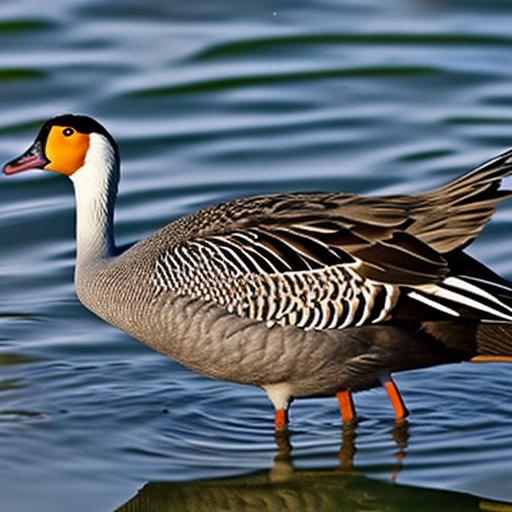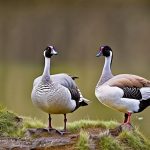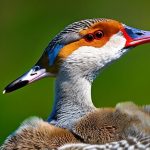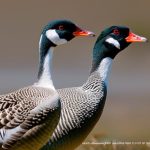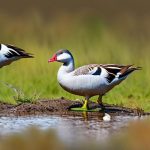Domestic geese are known for their strong breeding instincts and can be prolific breeders if given the right conditions. Understanding the breeding cycle of domestic geese is essential for anyone considering breeding these birds. The breeding cycle of geese typically begins in the spring, when the days start to get longer and the weather begins to warm up. This is the time when geese become more active and start to exhibit mating behaviors. Geese are monogamous birds, meaning they form long-term pair bonds with a single mate. Once a pair has formed, they will typically stay together for life, although in some cases, they may choose a new mate if their original partner dies.
During the breeding season, geese will start to build nests and lay eggs. The female goose will lay a clutch of eggs, usually between 5 and 12, depending on the breed and age of the bird. The eggs will then be incubated for around 28-30 days before hatching. It’s important to understand the natural breeding cycle of geese in order to provide the right conditions for successful breeding and to be prepared for the responsibilities of caring for breeding geese and their offspring.
Factors to Consider Before Breeding Your Geese
Before deciding to breed your geese, there are several important factors to consider. First and foremost, you should consider whether you have the time, resources, and knowledge to properly care for breeding geese and their offspring. Breeding geese requires a significant time commitment, as well as knowledge of their breeding behaviors and needs. You will also need to consider the space and facilities available for breeding geese. Geese require a safe and secure nesting area, as well as access to clean water and suitable food.
Another important factor to consider is the health and genetics of your geese. Breeding geese should be in good health and free from any genetic defects or hereditary diseases. It’s also important to consider the temperament and behavior of your geese, as aggressive or overly timid birds may not make good breeding candidates. Finally, you should consider the market demand for goslings in your area. Breeding geese can be a rewarding endeavor, but it’s important to ensure that there is a market for the offspring before embarking on a breeding program.
Preparing Your Geese for Breeding
Preparing your geese for breeding is essential for ensuring a successful breeding season. One of the most important aspects of preparing your geese for breeding is providing them with the right diet and nutrition. Breeding geese require a balanced diet that is high in protein and essential nutrients to support egg production and the health of the breeding pair. You should also ensure that your geese have access to clean water at all times, as dehydration can have a negative impact on their reproductive health.
In addition to diet and nutrition, you should also provide your geese with a suitable nesting area. Geese prefer to build their nests in a quiet and secluded spot, away from disturbances and predators. You can provide nesting materials such as straw or hay to help your geese build their nests. It’s also important to ensure that the nesting area is clean and free from any potential hazards. Finally, you should monitor the health and behavior of your geese in the lead-up to the breeding season. Any signs of illness or stress should be addressed promptly to ensure that your geese are in the best possible condition for breeding.
Choosing the Right Breeding Pair
Choosing the right breeding pair is crucial for successful breeding. When selecting a breeding pair, it’s important to consider the health, genetics, and temperament of the geese. Look for geese that are in good physical condition, with bright eyes, clean feathers, and a healthy appetite. It’s also important to consider the genetic background of the geese, as breeding from birds with hereditary health issues or defects can lead to problems in the offspring.
In addition to health and genetics, you should also consider the temperament and behavior of the geese. Look for birds that are calm, friendly, and well-behaved, as aggressive or overly timid geese may not make good breeding candidates. It’s also important to consider the compatibility of the breeding pair. Geese form long-term pair bonds, so it’s important to ensure that the birds get along well and are compatible with each other. By carefully selecting the right breeding pair, you can increase the likelihood of a successful breeding season and healthy offspring.
The Spring Breeding Season: Ideal Timing and Conditions
The spring breeding season is the ideal time for breeding geese, as this is when the days start to get longer and the weather begins to warm up. Geese are seasonal breeders, and their breeding instincts are triggered by the changing seasons. The longer days and warmer weather signal to the geese that it’s time to start mating and breeding. In addition to the natural cues provided by the changing seasons, there are several other factors to consider when breeding geese in the spring.
One important consideration is the availability of suitable nesting sites. Geese prefer to build their nests in quiet and secluded areas, away from disturbances and predators. You should provide your geese with access to suitable nesting materials, such as straw or hay, to help them build their nests. It’s also important to ensure that the nesting area is clean and free from any potential hazards. Another important factor to consider is the availability of suitable food and water. Breeding geese require a balanced diet that is high in protein and essential nutrients to support egg production and the health of the breeding pair. You should also ensure that your geese have access to clean water at all times, as dehydration can have a negative impact on their reproductive health.
Signs of Mating and Successful Breeding
Once the breeding season is underway, there are several signs to look for to indicate that your geese are mating and breeding successfully. One of the most obvious signs of mating is the behavior of the breeding pair. Mating geese will often engage in courtship displays, such as head bobbing, neck stretching, and vocalizations. You may also observe the male goose mounting the female and mating with her.
Another sign of successful breeding is the behavior of the female goose. After mating, the female goose will start to build her nest and lay eggs. Geese typically lay a clutch of eggs, usually between 5 and 12, depending on the breed and age of the bird. The eggs will then be incubated for around 28-30 days before hatching. It’s important to monitor the behavior of the breeding pair and the female goose in particular to ensure that the breeding process is progressing as it should. By being observant and attentive to the behavior of your geese, you can ensure that they are mating and breeding successfully.
Caring for Breeding Geese and Their Nesting Area
Caring for breeding geese and their nesting area is essential for ensuring a successful breeding season. One of the most important aspects of caring for breeding geese is providing them with the right diet and nutrition. Breeding geese require a balanced diet that is high in protein and essential nutrients to support egg production and the health of the breeding pair. You should also ensure that your geese have access to clean water at all times, as dehydration can have a negative impact on their reproductive health.
In addition to diet and nutrition, you should also provide your geese with a suitable nesting area. Geese prefer to build their nests in a quiet and secluded spot, away from disturbances and predators. You can provide nesting materials such as straw or hay to help your geese build their nests. It’s also important to ensure that the nesting area is clean and free from any potential hazards. Finally, you should monitor the health and behavior of your geese throughout the breeding season. Any signs of illness or stress should be addressed promptly to ensure that your geese are in the best possible condition for breeding.
Incubation Period and Hatching Process
After the female goose has laid her clutch of eggs, they will need to be incubated for around 28-30 days before hatching. During the incubation period, it’s important to provide the nesting area with the right conditions to ensure the eggs have the best chance of hatching successfully. The nesting area should be quiet, warm, and free from disturbances. You should also ensure that the nesting area is clean and free from any potential hazards.
During the incubation period, the female goose will spend most of her time sitting on the eggs to keep them warm and protected. It’s important to monitor the behavior of the female goose and the condition of the eggs throughout the incubation period. Any signs of illness or stress should be addressed promptly to ensure that the eggs have the best chance of hatching successfully. As the end of the incubation period approaches, you should be prepared for the hatching process. The eggs will start to pip, or crack, as the goslings inside begin to hatch. It’s important to provide the nesting area with the right conditions to ensure that the goslings can hatch successfully and safely.
Raising Goslings: Care and Feeding
Once the goslings have hatched, they will require special care and attention to ensure that they grow and develop healthily. One of the most important aspects of raising goslings is providing them with the right diet and nutrition. Goslings require a balanced diet that is high in protein and essential nutrients to support their growth and development. You should also ensure that the goslings have access to clean water at all times, as dehydration can have a negative impact on their health.
In addition to diet and nutrition, you should also provide the goslings with a safe and secure environment to grow and develop. Goslings are vulnerable to predators and environmental hazards, so it’s important to provide them with a suitable living space that is clean, warm, and free from disturbances. You should also monitor the health and behavior of the goslings throughout the raising process. Any signs of illness or stress should be addressed promptly to ensure that the goslings grow and develop healthily.
Considering the Future: Breeding Geese for Sustainable Farming
Breeding geese can be a rewarding endeavor, both personally and financially. By carefully selecting the right breeding pair and providing them with the right conditions and care, you can increase the likelihood of a successful breeding season and healthy offspring. Breeding geese for sustainable farming can also provide a valuable source of income and contribute to the conservation of rare and heritage breeds.
When considering the future of breeding geese for sustainable farming, it’s important to ensure that there is a market for the offspring. You should also consider the long-term health and welfare of the geese, as well as the environmental impact of breeding geese. By taking a responsible and ethical approach to breeding geese, you can ensure that your breeding program is sustainable and beneficial for both the geese and the environment. Breeding geese for sustainable farming requires careful planning, dedication, and a commitment to the health and welfare of the geese. By considering the future of breeding geese for sustainable farming, you can ensure that your breeding program is successful and beneficial for all involved.
Meet Walter, the feathered-friend fanatic of Florida! Nestled in the sunshine state, Walter struts through life with his feathered companions, clucking his way to happiness. With a coop that’s fancier than a five-star hotel, he’s the Don Juan of the chicken world. When he’s not teaching his hens to do the cha-cha, you’ll find him in a heated debate with his prized rooster, Sir Clucks-a-Lot. Walter’s poultry passion is no yolk; he’s the sunny-side-up guy you never knew you needed in your flock of friends!

